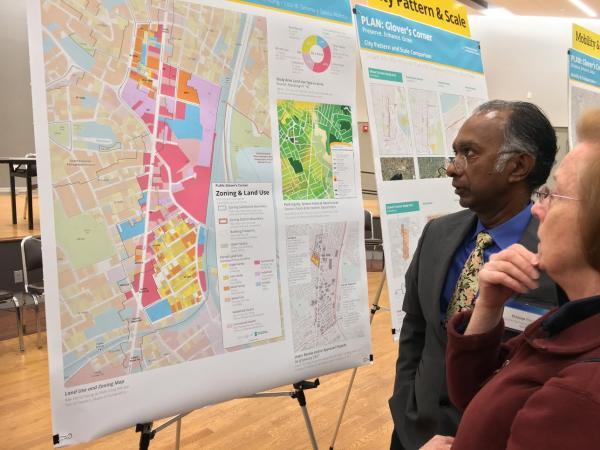March 9, 2017

Residents studied one of many large graphics on display at the BPDA's PLAN: Glover's Corner open house held on Wednesday evening at the IBEW Hall on Freeport Street. Jenn Smith photo
Some 165 people showed up at the IBEW union hall last Wednesday evening for an open house look at the Boston Planning and Development Agency’s PLAN: Glover’s Corner study. As attendees milled around the hall, they placed post-it notes on three presentation boards with questions and comments about topics like bike safety, traffic flow, public transit access, and affordable housing availability.
They also talked with planners, viewed large graphics, accessed demographic statistics, checked out land use and transit maps, learned about potential climate impacts for the area, and received a preliminary timeline for the project.
The Glover’s Corner study, which kicked off earlier this year, is still in the initial stages of community input. Following a “question campaign” in February, last Wednesday’s open house was the second stage in the process. Nominations for the project’s advisory group are due by April 3.
A walking and biking tour of the zone will take place in the spring, said Viktorija Abolina, one of the Glover’s Corner project managers.
Meetings for planning studies for projects in South Boston and Jamaica Plain/Roxbury were highly attended, with the JP/Rox drawing some community ire over the proportion of affordable housing included in the plan. Both plans were voted through by the BPDA board and are now in the zoning process.
Planners say they hope to see a similar engagement around the Glover’s Corner study, which stretches along the spine of Dorchester Avenue for eight-tenths of a mile from its northernmost point around Savin Hill Avenue to just north of the Fields Corner station and features large portions of underused industrial area.
“I do expect a good turnout in this community; we’ve been asking for it,” said Lara Mérida, BPDA deputy director for community planning.
“There are boundaries that are driven by the census block data,” Abolina said. “So those are the boundaries informed by all of the information about how many people live in the area, what are the demographic compositions, where are the ride shares and so forth.
“In terms of the soft boundary, we have to draw a boundary somewhere,” she said. “So along Dorchester Avenue we chose to follow the boundary for the Main Streets district, then be bound by Bay Street on the north and Dickens Street on the south, between the two transit lines. So the geographic boundary — I wouldn’t call the T a natural boundary — but it is an infrastructure boundary on one end and on the other side we have the Main Streets district.”
Within the study area, land use includes a mix of single- and multi-family housing, commercial space, industrial lots, and some mixed-use developments. Changes to zoning and use would be community-driven, planners emphasize, potentially leaving areas within the study boundaries untouched if residents didn’t feel that alterations were appropriate. Residential housing comprises 21 acres, or a quarter of the overall land in question.
But the 15 acres of industrial space and underutilized portions of the 36 acres of commercial space within the scope could use reassessment, planners said. “Dorchester Avenue could see some improvements,” Abolina said, “in terms of walkability, amenities. And then we see large parking lots around in terms of heavy car usage. That could potentially be an area that would see some growth.”
The portion of Glover’s Corner addressed by the plan is more demographically Asian — 38 percent, compared with 11 percent in Dorchester and 9 percent in the city as a whole — on par with the average of white residents — 24 percent — and has a proportion of black/African-American residents closer to the city average — 24 percent, as opposed to 44 percent across Dorchester.
Median rents for the area, which includes 724 units of existing housing, were down by 4 percent overall in 2016, according to the BPDA data. Median sale prices were up by 8 percent, now hitting $434,000 in the study area. Most units in the zone are renter-occupied, at a higher rate than across Dorchester or most of Boston.
Villages:
Topics:


